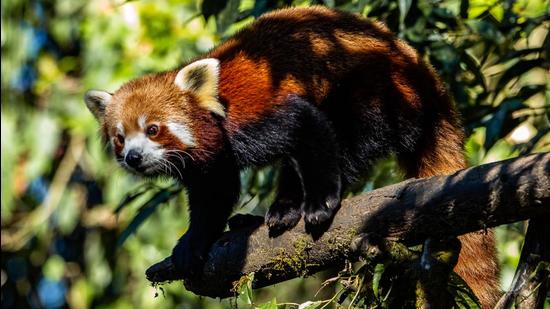Kunming Declaration: Is it all doom and gloom?
While there is much to worry about the state of world’s biodiversity, it’s important to cheer conservation success stories too
On October 13, more than 100 countries signed the Kunming Declaration, pledging to put the protection of habitats at the heart of their government decision-making. The declaration, which was signed at the United Nations Biodiversity Conference in Kunming, China, calls for “urgent and integrated action” to reflect biodiversity considerations in all sectors of the global economy.

However, crucial issues such as specific targets to stall mass extinctions, funding conservation in poorer countries and committing to biodiversity-friendly supply chains have been left for later discussions. The declaration is not a binding international agreement either.
There is much to worry about the state of world’s biodiversity. Unfortunately, with the mega Glasgow climate conference (COP26) around the corner, there has been minimal coverage of the Kunming meet, even though, as the Declaration, says “unprecedented and interrelated crises of biodiversity loss, climate change, land degradation and desertification, ocean degradation, and pollution, and increasing risks to human health and food security, pose an existential threat to our society, our culture, our prosperity and our planet”.
“The Kunming declaration is trying to go further than earlier Aichi biodiversity targets (2010-20) in protecting the planet’s biodiversity. It reaffirms that biodiversity loss is a reality and we need to put it back on a recovery path by 2030 so that by 2050 it start giving some results. Apart from other things it also mentions protecting 30% of sea or terrestrial area by well connected protected areas or area based conservation measures by 2030. To achieve this, ground based protection measures and involvement of communities will be must,” explains Parveen Kaswan, an Indian Forest Service official.
Biodiversity: Code red
According to a United Nations-backed report from 2019 by the Intergovernmental Science-Policy Platform on Biodiversity and Ecosystem Services, “an estimated 5% of all species would be threatened with extinction by 2°C of warming above pre-industrial levels — a threshold that the world could breach in the next few decades, unless greenhouse-gas emissions are drastically reduced. Earth could lose 16% of its species if the average global temperature rise exceeds 4.3° C.”
Global biodiversity is in steep decline, the WWF warned in its flagship Living Planet Report 2020. The numbers of mammals, birds, fish, plants and insects have fallen an average of 68% from 1970 to 2016, which is more two thirds in less than 50 years.
Closer home, the Centre for Science and Environment’s State of India’s Environment in Figures 2021, said India and its neighbours have together lost 90% of their original natural vegetation under their four common biodiversity hotspots with the biggest one — Indo-Burma hotspot — being the worst hit, reporting loss of nearly 95% of natural vegetation from originally estimated area of 2.3 million sq km.
The Fightback
Yet, as marine biologist Nancy Knownlton wrote in a 2017 paper in Nature, doom and gloom won’t save the world. The best way, she wrote, to encourage conservation is to share success stories, not to write obituaries of the planet.
One such heartwarming story is the conservation programme of red pandas in India. These animals are found in Sikkim, western Arunachal Pradesh, Darjeeling district of West Bengal and parts of Meghalaya.
The International Union for Conservation of Nature (IUCN) categorises red pandas as “endangered” as there are less than 10,000 breeding individuals left globally. Of these, India has estimated 5,000-6,000 animals. Over the years, red pandas, a reddish-brown arboreal mammal different from iconic black-and-white giant panda, faced several challenges such as habitat loss, poaching for meat and fur, and illegal capture for pet trade.
Fortunately, cross-border illegal trade has been curbed over the years and now, the West Bengal Forest Department’s red panda conservation programme is showing results.
“The geographical distribution of these animals is limited, and so if it wiped out from the region, the full species will be gone,” says Debal Ray, chief wildlife warden of West Bengal. “Besides they are slow breeders, extremely territorial and only eats two species of bamboos… So if we lose this species, recovery will be extremely difficult”.
The department’s conservation programme breeds these animals in captivity and then they are released in the wild. This is a difficult process. Red pandas, solitary animals, need adequate cover to feel comfortable to breed. Fortunately, the Padmaja Naidu Himalayan Zoological Park in Darjeeling has been successful in creating the right environment for breeding. A new set of red pandas will be released in the wild in January, 2022.
Then there is the question of providing the right food (last year the sudden flowering of all bamboo trees led to a shortage of food) and also the successful hard release of animals bred in captivity into the wild. “Sometimes, they do take time to acclimatise in the wild, and are reluctant to move out of their cages… it’s a long and tedious process before the animals gain confidence to venture out,” explains Ray. “The animals are also tagged to see how they are faring in their natural habitat”.
The department is also trying to build another set of population of red pandas in the Neora Valley National Park and Singalila National Park, both near Darjeeling. To ensure genetic diversity, good pedigreed pandas have been sourced.
Scientists from the Zoological Survey of India are also building a DNA database for red panda populations in the country. The reference DNA database for existing populations of red pandas will aid conservation efforts and come in handy to combat illegal wildlife trade by helping law enforcement officials assign the seizure (of illegal wildlife trade derivatives) to the source of origin, which would aid prosecution, reported Mongabay India.
All Access.
One Subscription.
Get 360° coverage—from daily headlines
to 100 year archives.



HT App & Website







